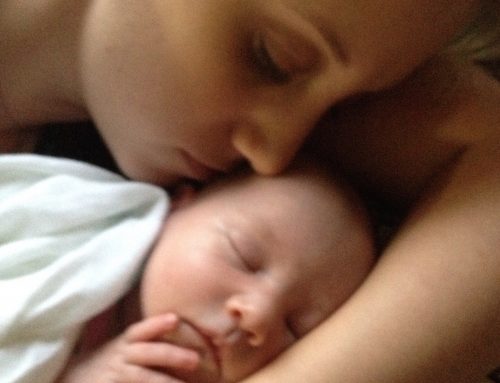I’m getting confused between how to teach my baby how to “self-settle” and not employing “control crying”. Can you explain the difference, at what age you can start to teach self-settling and the best way to do it?
This is a couple of edited excerpts from the chapter on “Sleep” from my new book “Your Cherished Baby” published by Pan Macmillan and released on the 1st August 2014.
Read on……
There is a world of difference between the newborn under 3 months and older infants. At this age the problems are not so much ‘sleep’ problems but that of general crying and fussiness.
In the first weeks babies sleep pattern is mostly dictated by their stomachs. When they’re hungry they wake, when they are satisfied, they sleep.
There is good scientific evidence to suggest that in the early months, prompt attention to distress leads to less frequent waking and disruptive crying patterns later on.
So, always check that your baby is not hungry. Remember that some babies require another feed within an hour of the last one. Studies have shown that the stomach may empty within 30 to 40 minutes following a breastfeed. Don’t worry if he falls asleep on the breast. This is not an important issue until one gets nearer 6 months of age.
If he does not fall asleep spontaneously following his feed, all you should do is keep him calm and keep him close. Babies cannot be taught how to sleep. The human newborn baby emerges in a relatively immature state, so he will respond to an environment that reminds him of the womb. That is:
1) He’s snugly contained (but not so tight it interferes with his breathing) with rounded back and contained, flexed limbs. In the womb all the limbs are flexed, elbows, hips and knees and that posture is comforting.
2) He is surrounded by rhythmic noise (the primary noise within the womb is that of mother’s heartbeat).
3) Within the amniotic fluid, he was immersed in the taste and smell of mother and her diet. He loves lying skin to skin with his mother, with as much skin crammed against her as possible.
4) It is also very low key and boring within the womb. The inside of the uterus is like a float chamber, visually very unexciting. The environment is quiet, meditative, and calm.
If you can reproduce this environment it is likely your baby will sleep.
Prevention of Sleep Problems: 3 – 6 months
About three quarters of babies start to sleep more during the night than the day as they head towards three months of age. On average between 3 and 5 months infants are sleeping for about 10 hours at night, with the longest sleep being between 6 and 7 hours and 75% of babies at this age have at least a 5 hour stretch.
If you have a baby who can’t manage this, as she heads beyond 3 months (depending on the individual) there is good evidence to suggest that a gentle programme to encourage her to prolong sleep will pay dividends. I emphasise that this is a ‘no cry’ preventive program. It is not designed to ‘teach’ the baby to sleep – and they are still too young to learn, but it will help establish for herself the ‘normal’ structure of sleep that most babies exhibit at this age.
The concept is to gently disassociate the act of waking, with the reward of feeding which becomes a conditioned reflex. If, whenever we wake, we are fed, we will tend to wake more often. By avoiding reinforcing this wake/feed behaviour, and by reinforcing quietness, we will decrease the tendency to wake.
Thus:
1) Make the first feed of the day in a brightly lit room to switch on the day/night diurnal hormone rhythm in the baby’s body.
2) Make the difference between day feeds and night feeds to be as obvious as possible. Also cluster activities such as playing, changing and feeding into discrete episodes during the day, interspersed with periods of calm, and hopefully naps. During the night however the environment should remain dark, quiet and unstimulating.
3) If she lets you, introduce placing the baby into the cot before she falls asleep. But if she insists on falling asleep on the breast, let her at least for the first few months. The cot should be in the same place every night. From 3 months, if possible, bedtime should be at approximately the same time, with the use of the same routines, songs and words.
4) When the baby re-wakens in the night, don’t delay going to her but delay the start of the feed for a short while. So change her nappy, give her a cuddle, walk with her, all in a calm, dark environment. Then feed her.
This programme should be introduced gradually, with stops and starts over a number of weeks. I emphasise, it does not involve leaving the baby to cry. It is merely to allow her to practice her own settling abilities and to make sure you don’t reinforce a cry/reward reflex.
As mentioned above, by the age of three months about 75% of babies have spontaneously initiated a good day/night sleep difference. Studies show that utilising the above four step regime will improve most of the other 25%. It is not that they are learning something (because, as I said, they are still too young to learn very much at all). What the program does is establish the innate structure of behaviour that is present in every baby at this age, which helps them to regulate their sleep patterns.










This is where we are at at the moment. When will this book be our? I would love to read more about the 3 to 5 month stage. Does your other book cover this?
Thanks
New book will be out in July 2014. The new book covers infants and toddlers (and mothers too!).
Hope you enjoy it when it finally hits the book shops!
Regards,
Howard C
Just wanted to say I’ve just read everything you’ve posted on your blog and enjoyed it immensely. Some very helpful information here, will be keeping up with your posts for sure. Thank you!
Baby on Board is extremely helpful (it’s my favourite book) as is this information on sleep. Do you have any excerpts you can share on babies 6+ months? I look forward to your book!
Got a whole chapter on the subject in the new book “Your Cherished Baby” out in July! Excerpts are hard as there is a bit of theory behind it. I’ll look into it.
Thanks for your post and remarks!
Hi Howard, It is a really helpful tool being able to replicate a mothers womb. Using a small clock that ticked like a heart beat was all we needed to assist in our bubs sleep.
Thank you so much for your blog and the reassurance! I can’t wait to read more in your book. Do you have any blogs or books on teething?
Thanks again!
A book on teething would be very brief. “Teething causes nothing but teeth” is one famous quotation. Someone did a study where one group of doctors examined babies’ mouths in a daycare every day and another group of childcare workers made daily notes of their behaviour, temperatures, fevers, rashes and runny tummies. After a few months they compared notes: no correlation at all. Most issues were caused by viruses that just happened to be caught at the time of tooth eruption! Book out next week with more! Howard
I have both your books and absolutely love them. Do you have any tips for daytime settling? My 14 week old son settles well (we use your advice!) at night but day naps are a struggle and sometimes only 20min. We don’t ever leave him to cry and he can still take 20-30 min to settle with rocking, cuddling in arms and being rocked/patted in the baby carrier.
Hi Simone, Sorry just seen your question.
At that age you take what you can. Be sensitive to his tired signs and get him down as soon as you see them. Then accept what he does for the time being. However you might like to make his daytime a little calmer and make his nap environment really boring, so there is nothing to attract him to stay awake for. But at this age things change week by week so don’t despair – he’ll be totally different in a few weeks!
Hi Dr Chilton. There’s so much conflicting information out there about settling babies, it’s great to see clear information with scientific basis, so thank you. Re this and your recent control crying article, I’ve been using control crying taught to me at a sleep school (private hospital) for my now 6 month old baby for around 10 weeks. I spoke to several health professionals first and no one suggested it wasn’t appropriate at this age. I’m now changing my approach but am worried that given her young age (barely 4 months) when we started that irreversible damage has been done. Is that your opinion? As I can’t turn back time (much as I’d love to), do you have any advice to ‘reverse’ or minimise the ill effects?
In controlled crying there are three factors that are relevant:
1) Context of the home. If it’s a generally loving, comforting home that is very positive and offsets the worries about CC
2) Dose of CC. If it done over and over again over month it is more likely to create a problem than short and sweet.
3) Temperament of the baby: Some babies are more laid back and can cope with being left more than others.
Short periods of CC are probably not harmful long as the rest of the environment are loving and nurturing. I’m sure you’ll remove the bad effects soon!
Hi Dr Chilton,
My daughter is 8 months going onto 9 months and wakes every 3 hours at night and day naps are a stuggle. My husband and I are against letting her cry but it seems that’s all she does until I offer her my breast. Does your book help to teach self settling for her age?
Thankyou
I’m not sure I like the expression “teaching self-settling” – it’s got a lot of baggage from the ‘routine-based parenting’. Just feed her, she will develop just fine and learn to calm herself in her own time. You can only make it worse by pressuring her.
Hi Howard, Very interesting post, particularly about the wake/feed behaviour for 3-6mths. It’s such an easy habit to get into!
Hello Howard,
Your post was very interesting to read. But I do have few concerns and questions. Firstly, I am from India and here the feeding and child upbringing dynamics are very different. As there exists a culture of Joint families majorly, there are many mouths with many advices. I firmly put my foot down as far as my child and his issues are concerned and do what best fits according to me. However, of late my 6.5 month son has suddenly started feeding at a gap of every 5 to 10 mins. He sleeps on my breast and after the gap of 15 to 20 minutes when I slowly withdraw my breast he wakes up and this continues. He sleeps for 1.5 hours only at a stretch. And this is exhausting me. He co sleeps with me only during nights. Please suggest me what best can I do to make him sleep longer? He’s started his solids and eats 3 solid meals. It would be a great help. Thanks.
There is no doubt he will stop feeding that often without you doing any thing different soon. Babies are hard to manipulate without major protest at that age. If you wish to continue to bed-share (which I applaud) just hang in there a little longer and continue to gently remove the breast every now and again and he will improve. As he gets older this will change anyway and he will remain secure and confident in you. 6.5 months is still a baby. Also check out Georgy’s motherhood Musing (2) on this site, on this subject.
Hi Dr Chilton, is it ok to implement the above 4 step strategy for a premature baby? My Bub is now 12 weeks corrected we currently feed and cuddle him to sleep at night and rock him to sleep during the day he only sleeps about 40 mins each time we put him down to nap. I’m just wondering if the strategy is too much for him and if he might need a few more weeks. Thank you
He sounds like he’s doing just fine. It shouldn’t be too different for a ex-prem with age calculated corrected. However this strategy should only be used if you insist for your own reasons. Babies prefer you to wait and continue as you’re going now for a while longer (me too)!
Hi Dr Chilton
My baby is just over 4 months old now and sleeps well through the night with 2 feeds (one a dream feed). However during the day he only has very short naps and can get quite cranky from being over-tired. As such we have no defined schedule in terms of time as I tend to put him down when he is tired. He will usually have 3 or 4 naps which will be 30-45 minutes each.
I have recently hired a nanny to look after him one day/week whilst I am home working. She has emphasized enforcing a schedule with nap times and trying to “stretch” him to these times even if he is tired before them. Just wondering what your opinion is on this?
Thanks!
The nanny’s method sound draconian and completely inappropriate for a baby at this age. He rhythms sound excellent for his age. You might discuss with the nanny about her changing her methods (or perhaps not working for you at all……).
In addition to the above post- the nanny also suggested leaving him to cry (gently) for a period of time after he wakes from these short day sleeps to see if he will go back to sleep. I’m not sure if there is a technique to get him to extend the time he sleeps for during his day naps, or should I just accept that he is a cat napper during the day and he will sleep well at night?
Cheers!
Brylie
I’m not sure I really like what your nanny says. Use your feelings and mother’s instinct. Your baby, your way. Maybe try patting him to see if you can extend his naps but be there for him, don’t leave him to cry.
Hello Dr Chilton,
I’m glad i came across this website this morning, being first time mum, and worrying about spoiling my 8week old bub with the boob (breastfeeding and pacifying). I came across the Save Our Sleep book as recommended by a friend but has found it very stressful for my bub and I, having such rigid routines, rules, and time schedule. I gave up after day three. However what i have read had stayed at the back of mind. Therefore I’m happy to see that there is a more gentler approach to settling. My bub has just recently started waking frequently at night, the past three nights it has been almost hourly. And i am very keen to start your 4 steps. However not sure how long should i delay the feed? Looking forward you reply. Thank you.
Delay for no more than a few minutes – just so the baby finds that feeds at night are slightly harder to get! Glad you’re going to ignore Save our Sleep, it’s a dreadful book without a shred of real information behind it.
Dr. Chilton, I have done your 4 steps which worked great thank you. And have bought and read both of your books. My bub is almost 4months and had just recently started to sleep poorly again. I have read about the 4 months sleep regression, but do not remember encountering this in your books? Unless I’ve accidentally skipped it and missed it. Now, unlike before, after the night feeds he cries and have trouble going back to sleep. Before, after the feed he pretty much would go back to sleep straight away. The past few nights i have been needing to rock/cuddle him, and sometimes even with this he is protesting.
I didn’t think I needed to say that babies are inconsistent over the early months! They do things like this regularly and a couple of months later, they stop doing them, unless you panic and help perpetuate the issue. Try reading “Georgy’s Motherhood Musing Blog “This too shall pass” on this site.
For some reason, despite knowing that babies are inconsistent with their sleeping, we still try to find ways to make them sleep better! Hence the big market on “making babies sleep better”. I shall blame that previous post on my lack of sleep. Haha! Thank you again Dr. Chilton.
Hi Dr Chilton
I’ve just finished reading Your Cherished Child. i am struggling with my 5month old and getting him to sleep (ex prem 16weeks corrected) we usually rock him to sleep however the last month he screams so hard when we are rocking him. It starts as a protest and then escalates to an intense scream. We always stay with him rocking him we thought he might be getting too big for the rocking and pop him in his bassinet and stroke his head and pay him but again this seems to only work on occasion with a lot of protest. We are not sure what we are doing wrong? Do you have any advice?
There are many variables. Are you breastfeeding? Where does he sleep – next to your bed, or own room? Is this a recent change? Does he nap OK? What’s the rest of the night like?
If you are in Sydney or Northern Rivers come and see me. If not, we could phone or Skype consult. One size does not fit all! Email is a poor medium for this discussion!
Thank you I’ll definitely make an appointment!
Hi Dr Chilton
I’m struggling with knowing what a good bedtime us fir nt 15 week old. Her daddy gets home at around 7 so I like them to be able to spend some time together. Also her naps sometimes finish at 7 or 8 and I wonder if this confuses her when I then give her a shower and try to put her to sleep after such a late nap.
Thanks
At 15 weeks the babies barely recognise bedtime routines. Also After a 7-8pm wakeup from a nap it is unrealistic to expect them to go to sleep. Generally if they are to sleep at 8pm they should be woken by 4pm. However this usually doesn’t work very well as waking babies at this age can make them cranky. If you are in Sydney or Northern Rivers come and see me. If not, we could phone or Skype consult. One size does not fit all! Email is a poor medium for this discussion!
Hi Dr Chilton,
I was hoping you may have some advice on helping my 9 month old to self-settle at night.
She is fine settling herself to sleep during the day but still has trouble at night. I bottle feed her formula during the day and just before bed, but still offer breast during the night when she wakes. Lately I’m having to feed her at least twice during the night as she will fall back to sleep with me patting her back every other time. I try to ensure that she’s had enough food/milk, making sure she’s not too hot or cold, and she’s never used a dummy. She’s never really been able to settle herself to sleep at bedtime, but her night time wakings seem to have gotten worse from about 7 months.
I also fed her to sleep at night when breastfeeding but stopped this around the 7 month mark. I have tried to be persistent with her self-settling as I read this would help with her night wakings…
Thanks so much.
Krystal
There are many variables. I note she is rewarded significantly from waking at night. Let’s discuss this on a phone or FaceTime consultation. See http://www.babydoc.com.au/shop.
Hi Dr Chilton,
I have a 3.5 month old who sleeps pretty well at night (we have used the same bedtime routine since she was 2 weeks old) but only seems to fall asleep with me (mum) and only falls asleep at night when I nurse her to sleep. I have to do this a couple of times before she goes down properly. On average I’m only waking up once or twice during the night. But, during the day she only cat naps – 4-5 times 20 mins and wakes up whinging. Should I be trying to extend these naps or is cat napping something she will grow out of? She also needs me to rock her to sleep during the day in bouncer or using the swing. Am I setting up bad habits?
She is too young to be developing habits. Cat napping is common but extend them if she allows it – otherwise don’t fret. Nurse her to sleep, it’s fine. Things change.
Hi,
My son is 13 weeks. He wakes at regular times at night and not always for a feed. He goes down at 830 after a bottle, he can settle himself with a dummy, then wakes at 12 and 2 usually resettled with a dummy, then 3 for a breast feed, then wakes at almost hourly intervals until 830, and won’t resettle without cuddles or coming into our bed, where I think the smell of my milk wakes him. I also have to rock him to sleep for his naps during the day and continue to cuddle him for the whole nap, and resettle him by rocking him multiple times a nap. I am wondering how to get him to resettle on his own and take naps without being cuddled, as I am just so tired.
These things change week by week. Have you tried the 4 step programme in the 2nd half of the article you read “Helping Babies to Settle”?
He is only 13 weeks old so may still be a little overstimulated and has not adjusted yet. Hang in there a few more weeks. Put him in your bed (but stick to the bed-sharing rules) or cuddle him. He is still a very young baby (a foetus on the outside) so can’t be expected to settle himself without you.
Hello, Im in the up every 2 hours at 4 months still catagory and I don’t think I’d be able to stay awake to read even two pages of your book ( sad face) I will try to re settle without food but what if it goes from 0-100 of crying by the time I’m by the cot?! Only thing that seems to settle is a feed but I can’t do this for much longer.
Thank you for your time, we all truly appreciate it!
Waking to feed is really common and normal at this age. Delaying it or trying to avoid the feed will usually make them more unsettled. Perhaps move the cot close to your bed so you don’t have to get up to feed him?
Dear Dr Chilton,
I have been trying for weeks on end to help my now 15 week old baby sleep on her own. We even brought in a sleep consultant that practiced controlled crying (which I was unaware of). Needless to say nothing has worked and it was truly music to my ears to hear you say that self settling is only beneficial from 6 months.
It’s so relieving to finally hear someone say that it’s ok to do what’s only natural and not be judged on nursing/cuddling/rocking baby to sleep.
I love my daughter dearly and give her anything she wants but my problem is that she will only sleep on me. I have been cuddling and rocking/bouncing her to sleep since birth but I cannot seem to put her down.
Do you have any advice on how to wean her off this?
I really appreciate your time to comment.
Have a read of this later blog – this might help. Alternatively arrange a consultation with me – either at one of my offices or on FaceTime!
https://www.babydoc.com.au/sleep-young-infant/